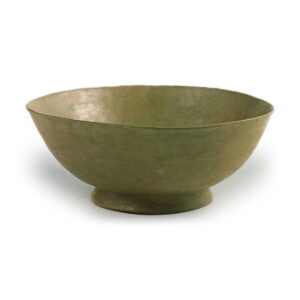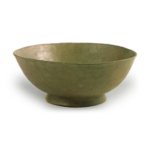
In China, a small bowl is called a bowl, and the character for “grudge” is also used, but the character for “bowl” was not used in ancient times. Both types of bowls were ceramic rice bowls that also served as drinking vessels. The “怨” refers to unglazed ware, while “琬” refers to glazed earthenware. Bowl appears to refer to the later stone ware. Bowl is a common character used to distinguish lacquerware from pottery. In Korea, early Yi Dynasty wares were influenced by the Song and Yuan dynasties in China, and the edges became thinner and more warped, with iron glaze inlays on line engravings, followed by Ming dynasty-style underglaze blue ware. In the latter half of the Li dynasty, the white porcelain became more common and the edge warping became less and less common. In general, however, plain wares were the norm in each period, with staining limited to the best wares. As for regional differences in bowl shapes, those from North Korea, on the contrary, have almost straight bodies, open mouths, and slightly larger elevations. In all periods, tableware was generally earthenware, but silverware was still used by the aristocracy, brassware was used during the winter season, woodenware was used by Buddhist monks, and most common items were limited to ceramics. What we call Koryo tea bowls in Japan are rice bowls made by Koreans. The word “go-gi” is also used to describe the bowls called wu-gi, but the correct term is go-gi, which were originally lacquered bowls used at Zen temples. The same shape as the lacquered bowls was called “kureki” in Japan. In some regions, rice bowls are still called “Kureki” even today. In Japan, there was also a silver bowl called “Kanamari” in the old days, and in the Heian period (794-1185), tea bowls were also commonly known as porcelain bowls. Today, porcelain rice bowls are called “rice bowls” to distinguish them from lacquerware bowls. In the past, bowls in Japan were mainly made of lacquerware, and the reason why Negoro bowls and Shuhira bowls were all large in size is said to be due to the old style of serving rice in a single bowl. Gorohachi tea bowls made of gosu (a type of porcelain) were also originally Korean-style bowls for serving a set of rice. The Nara bowl is a rice bowl with a lid, which was popularized from a bowl used for tea porridge in the Nara region. Modern rice bowls have changed from the old-fashioned deep Kureki style to a shallow, open shape. This was originally done in order to lighten the content according to the taste of the innkeeper. In modern times, rice bowls in Japan are mainly made of Mino porcelain, and the lacquerware rice bowls commonly used in the Tohoku region have almost completely disappeared. (Kokin Tosho Shusei, Chosun Ceramic Meikou, Kojiryuen)








